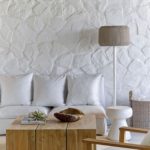Ancient practices of Feng Shui and Vastu Shastra have long understood that the layout, elements, and function of a space can impact the mood of those inhabiting it. How you decide to design your space is a very personal endeavor and hiring a good interior designer will ensure that the design best suits your character.
There is not a one size fits all approach when it comes to interior design and mental health, although there are a few tips that can be applied to almost all individuals in assisting in boosting your mood while at home or at work.
Here they are!
- Lighting: Lighting is crucial when it comes to the energy of a space. How many times have you gone into a home and immediately felt refreshed and happy, simply because there was a lot of natural light? The amount of light and the tone of the light will largely depend on the function of the space. For instance, in your bedroom it is best to have a warm light that induces relaxation, in contrast you will want your kitchen to have an abundance of natural light.
- Space and organization: Mari Kondo has shined light on the fact that less is more. Discard items you do not need. Remove any items that invoke negative emotion and make space for essential activities that will take place in that room. For instance, if you have small children in your home, do not select items in your home that will cause stress if damaged or potentially cause injury. Make sure that there is a level of functionality and comfort in your items based on how you intend to use the space in order to avoid unnecessary confrontation within yourself and others.
- Patterns/colors/textures: Studies have shown that certain colors and patterns can negatively or positively impact your mood. The same can be said for patterns and textures. The practice of Feng Shui has shown that bringing in natural textures, like wood, water, metal, plants etc into your home can greatly impact mood, and energy. Be careful to avoid, busy patterns in spaces that you inhabit on a regular basis, it is best to use those patterns in smaller, less essential areas.





You must be logged in to post a comment.